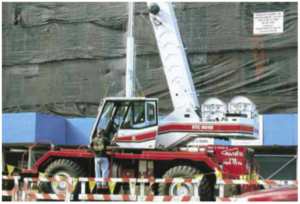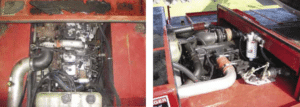This article originally appeared in the June 2010 issue of Crane Hotline. You can view the original edition here
A weak economy and government mandates are forcing crane owners and fleet managers to make tough decisions about aging machines. These days, many companies don’t have the luxury of letting even ancient machines go for pennies on the dollar on the used equipment market. Luckily, there are alternatives that not only meet green standards, but lengthen the life of a major capital investment.

According to an Associated Equipment Distributors survey, equipment purchasers and managers are taking a different direction in fleet management. Reported in the February 2010 issue of Construction Equipment magazine, the AED survey results found that fleet managers are focusing on controlling costs, emphasizing equipment utilization—and they are not purchasing new equipment. But that’s not necessarily a bad thing.
“We have options now,” says Robert Weiss, vice president of Cranes Inc., Maspeth, N.Y. “Normally we would have sold [an older crane] and bought new. In this turbulent economy, however, we are faced with a troubling problem. While it’s often prohibitively expensive to run older cranes, you can’t justify buying new and getting nothing for [an old one] on the market. Programs to extend the service life of older equipment offer crane owners a good solution.”
Many crane owners are also opting to install special particulate filters or even repower engines in order to meet federal and state emissions mandates, or as part of overall green initiatives. Some say once the economy picks up, the feds will be hot on the trail of engine emissions infractions. Repowering is a solution that does more than just clean the air for others. It can add years to the life of a crane.
A position of power
Cranes Inc. had six Link-Belt RTC-8040 Series IIs and two RTC-8030 Series IIs that were approaching 10 years of service. When shop mechanics came up with a list of 12 items that needed to be addressed, including new computers, electric swivels, heaters, and body work, a decision was made to turn the cranes over to WHECO Worldwide Services, a turnkey crane accident repair and restoration company, for a Service Life Extension Project (SLEP). The company is based in Richland, Wash., and has five additional service centers.
The cranes were shipped to WHECO’s Aiken, S.C., facility, and repowering was done in the process. Weiss says the decision to install like-new Cummins engines has actually landed his company a long-term contract.
“We had gotten a couple of jobs here in New York that came with more stringent air laws,” he explains, adding that on certain major state projects, Tier 3 engines are required. “We had already contracted with WHECO for the SLEPs when we got a deal to rent out two [RTs] for a long-term project, but they had to be Tier 3s. We have Groves that are Tier 3s, but they were all out [on jobs]. For the first two cranes WHECO worked on, we had them put new Cummins engines in, and they are now on a year-long rental.”
Weiss says Cranes Inc. automatically reaped the benefits from the engine repower. “After taking these older cranes and doing the SLEP and adding a Tier 3 engine, we really have a valuable tool. From what I’m hearing from customers, they’re fantastic, they’re running like new, and look new,” he says of the RTs. “Without that combination, we wouldn’t have had a year-long rental and been able to provide what the customer thought was a brand new crane.”
Cranes Inc.’s all-terrain crane fleet is comprised of late-model Liebherrs, the majority of which already have Tier 3 engines. Weiss says having those newer engines actually opens doors for his company. “For the most part, we’ve found having a Tier 3 engine will allow you to work more places.” Repowering the Link-Belt RTs was a smart investment, Weiss says, because “today’s rental rates don’t justify a new purchase, and selling them [at 10 years] would almost yield nothing. You have to figure out how to be creative, and this keeps [the RTs] in the fleet and gets more life out of them at a reasonable cost.”
Jay Shiffler, vice president of business development for WHECO, agrees. “There’s the flexibility now, of getting this crane into places it couldn’t go anymore,” he says of the Cranes Inc. re-powered machines. “Now it cannot be rejected, its emissions levels are fine, it meets local laws, and complies with almost any standards.” That can only be said of new cranes today, continues Shiffler, who also points out that in a couple of years, that new crane may not be compliant anymore.

Cummins dealer Cummins Atlantic Inc., Columbia, S.C., provided the engines, and, working with WHECO, actually re-powered the first crane in the project. WHECO performed all of the SLEPs, including the re-power on the second RTC 8040 of the Cranes Inc., machines. Rusty Ulmer of Cummins Atlantic says construction equipment owners in general are running their machines longer.
“People have increased the length of service of a machine,” he says. “Typically, you would run a truck for five years or 500,000 miles, where now they’re running for seven years or 700,000 miles. We’re seeing more maintenance because they’re going to mileages we haven’t seen before. It has a lot to do with the economy.”
Weiss says other crane owners should crunch the numbers for themselves while work is slow and cranes are idle. “I think this is something more people should consider at the 10-year mark,” he says. “If you don’t have the money to replace a crane, this is a good thing to do. Hopefully by the time they’re ready to be retired, the economy is better and there’s trade-in value for them. It’s a good way to get through this slow period.” Ulmer, too, suggests crane owners do the math. “A $500,000 piece of equipment or a $25,000 engine…you can justify a new engine a lot easier than you can a whole crane,” he says. Many crane owners hesitate to invest in a re-power project, Ulmer says, simply because they just haven’t investigated the possibilities. “When WHECO called me about re-powering these cranes, they said [Weiss had] talked to half a dozen people who’d told him to just replace the crane. Nobody told him to replace the engine. And it’s not a really complicated job to do.”
Other crane owners avoid powering up because they’re fearful of going from a mechanical engine to electronic technology. “Once they get electronics in and see the capability of the engine and the things they can do from both an operator and management standpoint,” they get over their trepidation, Ulmer says. “They’re getting a cleaner-burning, more efficient engine in the electronics. And they can tie into the machine through computers and monitor the engine for fuel consumption, service hours, work load, or service intervals.”
For instance, Ulmer says that typically on a turbocharged engine, which most diesels are, at the end of the workday, the machine should idle for three to five minutes before the operator shuts it down. “A lot of operators will go do something else and come back to the machine much later,” he says. “With an electronic engine, you can program it to automatically shut down after, say, five to seven minutes.”
A screening machine
To run RTs on jobs in the Big Apple, Cranes Inc. is also required to have diesel particulate filters, or DPFs, on their cranes. The add-on component, similar to a catalytic converter, filters out diesel particles. “Even though you put a Tier 3 engine in a crane, New York City says the Tier 3 is not clean enough,” says Weiss. “You have to add a DPF on top of that to filter the reduced diesel emissions from the Tier 3. From what I understand, it’s a growing situation nationwide.”
And that, says Shiffler, creates frustration among crane owners, especially where rentals are concerned, because every state has different regulations. “That’s what makes it very difficult for a crane owner to rent outside of the state he’s in,” he says. “In New York, he has to know the standards for Massachusetts, New Jersey, wherever his business takes him. In California, crane companies have to know what’s expected in Arizona, Washington, and Oregon, and vice versa.”
Since Bigge Crane and Rigging, San Leandro, Calif., can’t beat their state’s strict air emissions standards, it decided in January to join the bandwagon and create another service offering. The company became an active Cleaire retrofit emissions filter dealer and certified Cleaire filter installer for all on-road and off-road cranes. Sales and installations will be offered at every Bigge service facility in California, and a field-service fleet of certified technicians will install and service filters anywhere in the United States.
“We run a very diverse fleet,” explains Daren Griffin, service manager, Bigge Corporate, who says the company has invested a lot of time in understanding how to comply with the CARB regs. “We were in a unique position to help other companies,” he says. “We felt Cleaire [also in San Leandro] offered the best product on the market, and that’s how we started partnering on their filters.”
Griffin says putting a new filter on an RT, truck crane, or crawler buys the owner an extra three to four years on the life of the crane. “Because Cleaire offers a wide variety of filters for cranes, we can offer something to everyone,” Griffin says. The installation process usually takes about three days, on most cranes.
Depending on the size of the fleet, California has set a timetable in which crane owners will have to comply with the new diesel engine Tier 3 and later Tier 4 requirements. At press time, there had been no immediate need for crane owners to have them installed because CARB enforcement was on hold.
“They were anticipating the deadline for large fleets to be March 1st, 2010,” says Griffin. “While the deadline remains unclear, everybody thinks it’ll be based on the economy. When the economy rebounds, we can look for it to gain traction again.”




